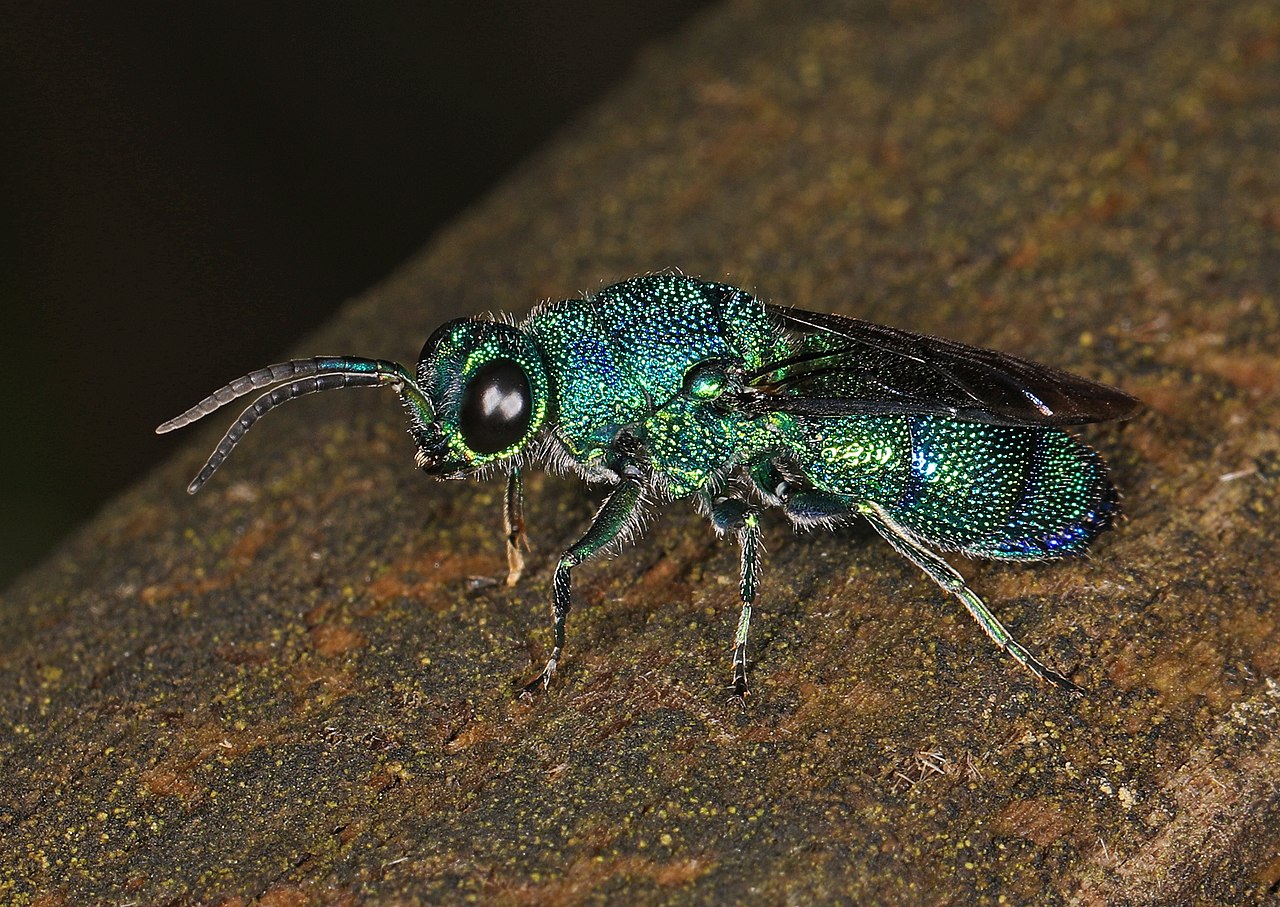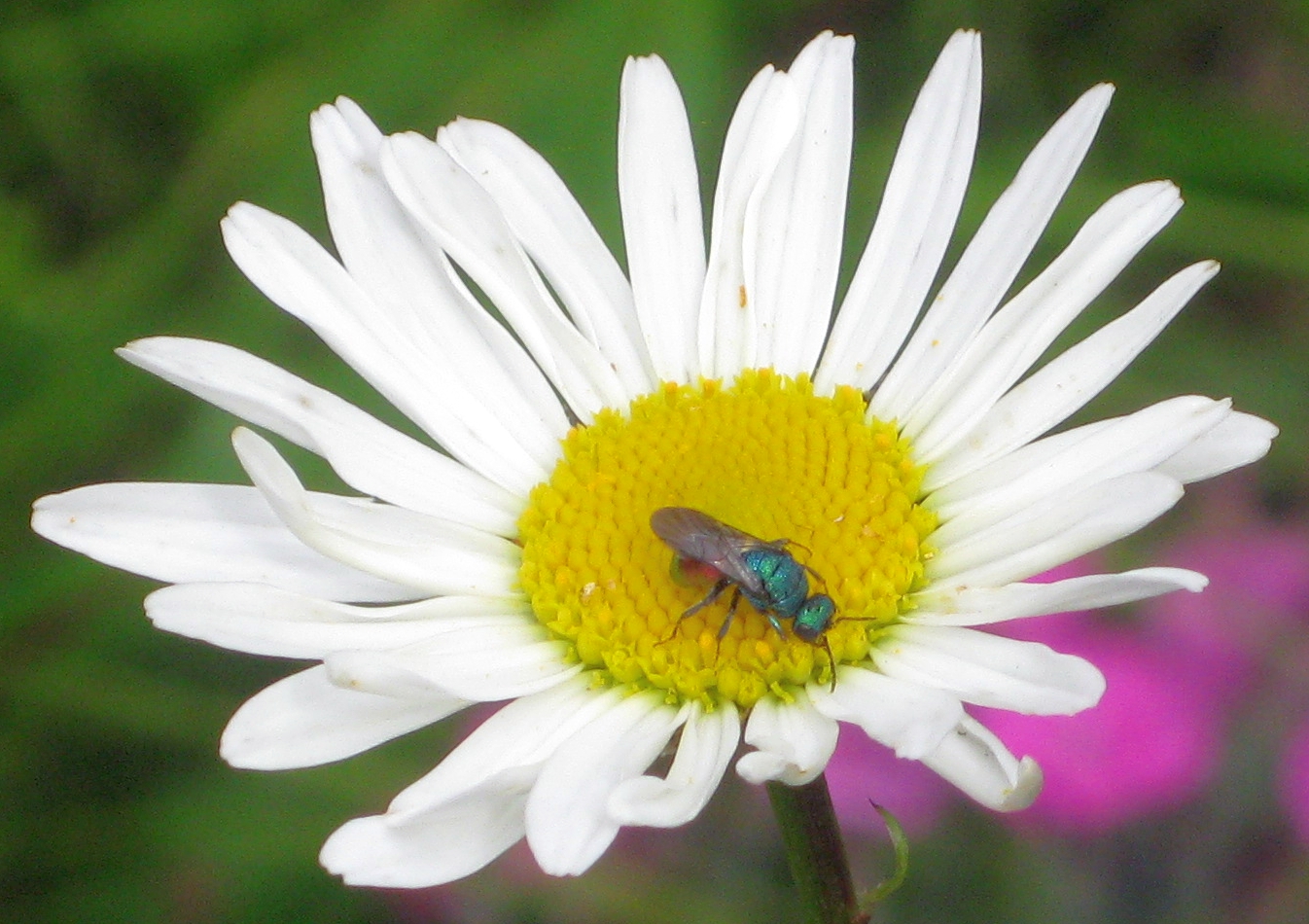Wasps are insects with narrow waists, belonging to the Hymenoptera order. It is not a bee or an ant. Some wasps can sting prey. They are often black and white, though green wasps do occur throughout the world.
If you are wondering if you saw a wasp or another insect, then continue reading below to find out more about green wasps.
Green wasps you may encounter include:
Table of Contents
1. Metallic Bluish-green Cuckoo Wasp
The Metallic Bluish-green Cuckoo Wasp (Chrysis angolensis) is invasive and parasitic. It was introduced into North America during the Second World War. It is believed it arrived on ships.
Today, these wasps are widespread throughout the United States, especially in areas close to the coast.

This wasp has a bright blue-green head, thorax, and abdomen with metallic reflections. The male has four segments on the abdomen, the female has three. They have flattened exoskeleton plates on the bottom. The female has a long ovipositor, protruding from the tip of the abdomen.
This wasp has two large eyes, one on either side of the head. There are three small simple eyes in a triangular pattern on the top of the head, right between the compound eyes. They have black antennae, that are short, comprising three segments.
These wasps can grow up to a quarter inch to seven-sixteenths of an inch.
2. Emerald Cockroach Wasp

Emerald Cockroach Wasps (Ampulex compressa), also known as jewel wasps, are solitary wasps. They belong to the Ampulicidae family, known for their unusual reproductive behavior. They are known to sting cockroaches, using the hosts for their larvae.
These wasps are found in tropical areas in Africa, Southeast Asia, South Asia, and the Pacific islands. They are more abundant during the warm seasons. In 1941, Ampulex compressa was introduced to Hawaii as a biocontrol method. This was unsuccessful due to the wasps’ territorial tendencies.
They have also been found in Sao Paulo and Rio de Janeiro in Brazil. These wasps have metallic blue-green bodies with red on the second and third pair of legs. Females can grow to twenty-two millimeters and males are smaller and cannot sting.
They go through four larval stages. The younger larvae feed on the cockroach’s leg with the last instar feeding on the internals of the cockroach. The larvae form spindle-shaped, thick cocoons seen outside the dead cockroaches inside the burrow.
3. Ruby-tailed Cuckoo Wasp
The Ruby-tailed Cuckoo Wasp (Chrysis ignita) is metallic and a solitary species that is seen in sandy quarries, tree trunks, and rocky outcrops. The female relies on nests of other wasps and bees, particularly the Mason bee, where she lays her eggs. Once the eggs hatch, they eat the bee larvae to develop.
The thorax and head of this wasp are shiny blue-green. The abdomen is deep ruby-red. They are common throughout England, Scotland, Wales, and Ireland. They have also been seen on the Isle of Man and the Isle of Wight.
Their habitats overlap with the host wasps that they parasitize. They are commonly encountered near quarries, walls, dead wood, and cliff faces.
4. Emerald Cuckoo Wasp

Emerald Cuckoo Wasps (Stilbum cyanurum) are large Old World species, belonging to the Chrysididae family. They can grow to twenty millimeters in length. Their color can range from blue-green to blue-violet, and some may include red-gold.
The wasp lays eggs in potter wasp nests, which include sphecid wasps and mega child bees. If you live in North Africa, Australia, Eastern Palearctic regions, Oriental regions, or southern Europe, you are likely to encounter this green wasp.
5. Blue Cuckoo Wasp
The Blue Cuckoo Wasp (Trichrysis cyanea) belongs to the Chrysididae family and is widespread in northern Africa, Asia, Korea, Japan, China, and most of Europe. Their preferred habitat is forest margins and clearings with sun-exposed dead trees.
This wasp can grow to eight millimeters in length. They are small and elongated. They can be violet or blue-green. Males are partially or completely black. There are three wide teeth at the tip of the abdomen.
6. Pseudomalus auratus

This is a species of cuckoo wasp that can grow to seven millimeters in length. The head and thorax are metallic blue with a red abdomen. They have a hairy thorax and head.
This small green wasp is common from May to October and is found on blackberry branches, raspberry branches, and dead wood. They are common throughout Europe, North Africa, and Asia.
They inhabit open areas, thickets, and forest edges where there are plenty of nesting hosts. They were accidentally introduced into the United States in the early 1800s.
7. Chrysis smaragdula

This wasp belongs to the Chrysidinae subfamily and was first discovered in 1775. They grow to fifteen millimeters, making them one of the largest in their subfamily.
They are common from May to October in the United States from northern New York to Honduras.
8. Hedychrum rutilans

This cuckoo wasp belongs to the Chrysididae family and is common in Austria, Italy, Greece, Portugal, Bulgaria, France, Spain, and Poland. They have metallic green heads and thoraxes with red spots. The abdomen is red.
Males tend to be greener and females are more golden-red. Both have hairy bodies. They are parasites of the beewolves. The female lays her eggs on the paralyzed honeybee, which serves as provisions for the beewolf larvae. The cuckoo wasps larvae feed on the honeybees and the beewolf larvae.
They can grow to ten millimeters in length and are common from June to September. You can see them feeding on flowers in sandy and warm habitats.
9. Euperilampus triangularis

This green wasp belongs to the Perilampidae family and is a metallic blue or green wasp. They are small, yet robust with triangular metasoma. They are strongly sculptured with a broad prothorax.
The first instar larvae are planidia and they gain access to the host, rather than relying on the egg-laying female.